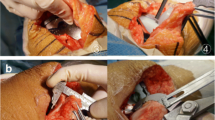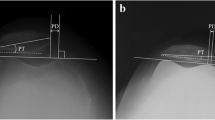Abstract
Minimally invasive surgery has recently been introduced in TKA surgery. The purpose of this study was to evaluate the effect of eversion of the patella, on safety and functional result after TKA. In a prospective, randomised, double blinded trial, 60 patients were divided in two groups: group A underwent TKA through a standard medial parapatellar arthrotomy, with patellar eversion. Group B underwent the same exposure, except for the fact that the patella was subluxed laterally. All other treatment protocols were identical. Outcomes were measured until 1 year postoperatively. Radiographic evaluation included AP, lateral, skyline and full leg standing radiographs. VAS, WOMAC score, Knee Society Knee and Function score were performed. Active and passive range of motion (ROM) and knee proprioception was measured. All patients underwent isokinetic strength testing. The mean passive ROM changed from 121° preoperatively to 121° postoperatively in group A, compared to 118°–131° respectively in group B at 1 year (P = 0.003). The mean active ROM changed from 112° to 115° in group A, and from 108° to 125° in group B (P = 0.005). All other parameters were not significantly different. Patellar dislocation without eversion for exposing the knee during TKA is a safe procedure and improves ROM at 1 year postoperatively.


Similar content being viewed by others
References
Aglietti P, Baldini A, Sensi L (2006) Quadriceps sparing versus mini-subvastus approach in total knee arthroplasty. Clin Orthop Relat Res 452:106–111
Callaghan J (2006) Internet promotion of MIS and CAOS in TKA by Knee Society members. Clin Orthop Relat Res 452:97–101
Chi PL, Foo LS, Yang KY et al (2007) Randomized controlled trial comparing the radiological outcomes of conventional and minimally invasive techniques for total knee arthroplasty. J Arthroplasty 22:800–806
Dalury DF, Dennis DA (2005) Mini-incision total knee arthroplasty can increase risk of component malalignment. Clin Orthop Relat Res 440:77–81
Engh GA, Holt BT, Parks NLA (1997) Midvastus muscle-splitting approach for total knee arthroplasty. J Arthroplasty 12:322–331
Faure BT, Benjamin JB, Lindsey B et al (1993) Comparision of the subvastus and paramedian surgical approaches in bilateral knee arthroplasty. J Arthroplasty 8:511–516
Floren M, Davis J, Peterson M, Laskin RS (2007) A mini-midvastus capsular approach with patellar displacement decreases the prevalence of patella baja. J Arthroplasty 22:1–57
Font-Rodriguez ScuderiGR, Insall JN (1997) Survivorship of cemented total knee arthroplasty. Clin Orthop Relat Res 345:79–86
Hofmann AA, Plaster RL, Murdock LE (1991) Subvastus (Southern) approach for primary total knee arthroplasty. Clin Orthop Relat Res 269:70–77
Karachalios T, Giotikas D, Roidis N (2008) Total knee replacement performed with either a mini-midvastus or a standard approach. J Bone Joint (Br) 90-B:584–591
Laskin RS, Beksac B, Phongjunakorn A et al (2004) Minimally invasive total knee replacement through a mini-midvastus incision: an outcome study. Clin Orthop Relat Res 428:774–781
Luring C, Hufner T, Kendoff D, Perlick L, Bathis H, Grifka J, Krettek C (2006) Eversion or subluxation of patella in soft tissue balancing of total knee arthroplasty? Results of a cadaver experiment. Knee 13:15–18
McAllister C, Stepanian JD (2008) The impact of minimally invasive surgical techniques on early range of motion after primary total knee arthroplasty. J Arthroplasty 23:10–18
Ranawat CS (1993) Long-term results of the total condylar knee arthroplasty. A 15-year survivorship study. Clin Orthop Relat Res 286:94–102
Roorda L, Jones C, Waltz M, Lankhorst G, Bouter L, van der Eijken JW et al (2004) Satisfactory cross cultural equivalence of the Dutch WOMAC in patients with hip osteoarthritis waiting for arthroplasty. Ann Rheum Dis 63:36–42
Rosene JM, Fogarty TD, Mahaffey BL (2001) Isokinetic hamstring: quadriceps ratios in intercollegiate athletes. J Athl Train 36:378–383
Sharma V, Tsailas PG, Maheshwari AV, Ranawat AS, Ranawat CS (2008) Does patellar eversion in total knee arthroplasty cause patella baja? Clin Orthop Relat Res 466:2763–2768
Tenholder M, Clarke HD, Scuderi GR (2005) Minimal-incision total knee arthroplasty: the early clinical experience. Clin Orthop Relat Res 440:67–76
Walter F, Haynes M, Markel DC (2007) A randomized prospective study evaluating the effect of patellar eversion on the early functional outcomes in primary total knee arthroplasty. J Arthroplasty 22:509–514
Author information
Authors and Affiliations
Corresponding author
Rights and permissions
About this article
Cite this article
Arnout, N., Victor, J., Cleppe, H. et al. Avoidance of patellar eversion improves range of motion after total knee replacement: a prospective randomized study. Knee Surg Sports Traumatol Arthrosc 17, 1206–1210 (2009). https://doi.org/10.1007/s00167-009-0863-4
Received:
Accepted:
Published:
Issue Date:
DOI: https://doi.org/10.1007/s00167-009-0863-4




